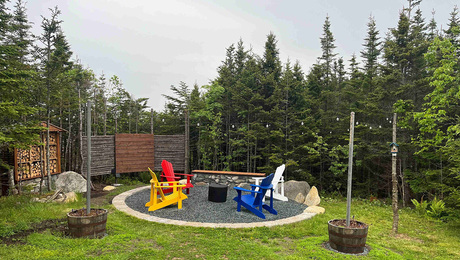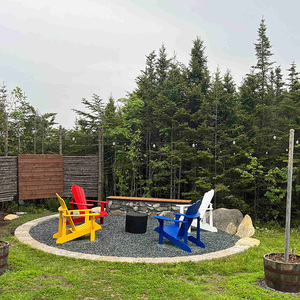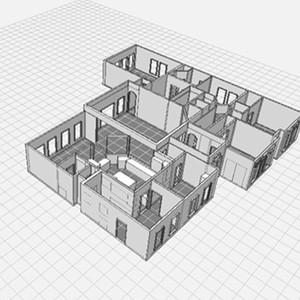There seem to be differing opinions on this one. What is the best way to install wide plank wood flooring. Planks are 3/4″ thick by 6″ to 18″ wide by 20 feet long, western red fir. Trees were cut and milled on-site, then given a T&G edge. Been drying for 3 years.
One line of opinions is to glue to wood subfloor and face nail using square nails.
One is NO GLUE, and face or blind nail. Any disadvantage to blind nailing with the wide stuff?
Location is Lake Tahoe, Calif. I want the rustic look, so some checking and cracking is ok, but I don’t want it to destroy itself. Glue doesn’t seem to allow for movement. But several have said glue will help to keep wide planks from cupping.
Lastly, what about nail pattern. Two or three per width? Into every joist (16 o.c.) or every other (32 o.c)? If glueing do you trowel whole area, or just apply to edges of boards?
Any advise would be appreciated since to date I have not found a general consensus.
Thanks in advance.



















Replies
My quick solution to your problem......
Rip all the wood down to 3" and t&G that. Install as usual.
Sorry I couldn't resist. Fact is, when I read your post I totally cringed. I would have no idea how a floor like that would behave. But if someone were making me do it, I think I would do about a 2" glue joint (v notched trowel) down the middle of the wide boards and face nail three nails across the width in every joist. I would also install on the hottest, driest day of the year with the boards coming in from being directly sun bathed for a few hours, days, weeks... Then pray a lot.
And another idea, it may be something to consider sealing the boards on all sides. Back and sides before installation. And I would absolutely glue and mechanically join the ends of every board. Biscuits or slip splines for sure.
Good luck. Sorry I couldn't be more help.
Rob Kress
Rob:
"Rip them to 3" ... That hurts! This is beautiful stuff (at least before it goes down).
Your advise is similar to what Carlaisle told me. Except they made no mention of the ends. Why fasten end to end? I always thought that the primary direction of expansion/contraction was across the grain (width), and that the changes in length are fairly insignificant. I can see an added advantage of helping to prevent the ends from lifting, but if joints fall over a joist shouldn't that be sufficient? I might have to buy a second buscuit jointer when I'm done, or at least a new blade...
Note that Tahoe area is pretty dry, with rather mild swings in humidity throughout the year. But pre-sealing (as long as it's compatible with the finish) may well be worth the extra effort. Thanks.
I was just joking abou the 3". I'm sure your planking is fantastically beautiful.
By joining the ends, you may help reduce the obvious appearance of cupping and bowing at the joints. I think this is mos likely the place that it would show up the worst.
Good luck,
Rob Kress
Carlise does wide plank flooring all of the time.. they said no glue.. I can't believe there is a glue made that will hold wood over a long time.. I've heard a few floors where someone felt glue was called for. The cracking sound as you walk over them will convince you that it's a foolish idea to glue..
I'm gonna do something differant on my wide plank floors.. rather then nail from the top I'm gonna screw from the bottom.. (because I have access to the underside of the floor I'll drill holes in the subflooring {from the top since I don't like sawdust falling into my eyes.} then I'll run short screws up into the finish floor. make the holes a little larger to allow for the normal expansion/ contraction of the wood.. That way you won't see any fasteners and with the slightly oversized allow proper movement of the wood..
If the planks should dry up more and shrink a little you could reach up and retighten any that loosen up..
Sounds labor intensive. Do your widths vary? How are you going to determine hole location for pre-drilling from above if they do? My shoulders ache just thinking about you with your arms overhead day after day installing screws. You gonna pre-drill pilot holes in the planks too? Interesting about allowing for movement. Hope it works for you. Sounds good in theory, kinda "retentive" if you know what I mean. I admire that. Report back on how it works out. What is your subfloor? I always thought fastening into the joists with wide plank was the way to go. But I'm not a flooring specialist. Hence all my questions.
As for crackling floor due to glue. I've heard the same kinda sound from a couple of installations where asphalt felt was used as an underlayment. I think the tar sticks and lifts when things flex (even a little). Sounded like walking on eggshells or potato chips. I woulda torn it up and started over. It was unbelievable!
I went astray there... Carlisle actually told me I could put a zig zag ribbon of const. adhesive down the middle, then face nail with square nails two for boards up to 8" wide, three nails otherwise. Since sub-floors are glued this way I see little possibility for glue-induced noise. Perhaps the installations you site used some other type of glue?
Edited 8/6/2003 9:49:16 PM ET by buildboy
Yes my widths vary.. The 18 foot long 12 inch wide planks of hard maple that will be in the center will go down one board at a time then I set the next board in place and look for where everything falls (outline with a pencil) and space my screws accordingly. Then I have these wonderful 22 inch wide burled oak boards that I'll picture frame around the maple followed by a maple border
My idea is to install in the summer when the humidity is at it's peak and the boards have swollen about as much as they ever will. I'll then set the boards relatively tight so that when they shrink the resulting gap will be as small as possible.
I can screw temporay blocks in place to hold everything while I go below and run the screws in.. but yes I believe that I should predrill all of the holes.. of course I'm anal as all get out.. The basement walls in my house are 22 inches wide steel reinforced concrete with 4000 psi mix and about a ton of rebar in it.. the footings are as much as 60 inches deep and 24 inches wide..
I did the calulations and I should be able to withstand a level 5 tornado in this house, of course Minnesota has never had a level five tornado but just in case.....
frenchy.. don't do it.. you have to be on top of your floor to make onsite adjustments , cut your lengths, open and close the joints..
you are never going to be happy trying to get your floor laid by screwing from below..
best plan is to either face nail with something like a Tremont square nail ( hammered head ).. with two nails per joist with an extra nail for every 6 " of width..
or
screw and bung the face , same spacingMike Smith Rhode Island : Design / Build / Repair / Restore
Mike,
I have these wide (22 inches) burled oak boards that if you went ahead and counter bored, and bunged as you suggest it would look like measles. definately ruin the look of all that great burl.
The floor will be too refined to accept visable nails and edge nailing is out of the question with 22 inch wide boards.. so what if it's labor intensive.. have you seen the pictures of my house so far? is there anything in that house that suggests that I'm lazy or look for labor savings? It is fairly easy to set the board in place and run below and screw in a few screws, then go upstairs and adjust as needed..
If my arms ache,, that's what they make Ibuprofen for isn't?
Glue and staple....no face nails. Use 3M Marine adhesive/sealant.
Ditch
I have done a few floors with second-growth redwood in widths of 10 to 12 inches, about 5/8 thick. With mixed success. Make sure your wood is absolutely dry.
I milled the planks myself into shiplap, then screwed down with a single screw and plugged them. No glue and no finish other than a little wax.
I have had no problems with cupping or splitting, but there has been quite a bit of shrinkage.
The only case where I succeeded in overcoming this shrinkage resulting from insufficient dryness was in following the precept "if you want a job done right, do it yourself." My supplier had given me another load of wood that was basically green, so I had no choice but to dry it myself. Only problem was, I had only two weeks to get the floor done.
So, following the advice of an old FW magazine, I constructed my own kiln and dried the wood myself. I used rigid foam insulation and duct tape for building the kiln, and a fan-powered kerosene heater to dry. Two weeks of heat and my wood was bone dry. Took a couple of hours to set up this kiln.
The floor came out well, and barely opens up even when the heat goes on.
Do what Mike suggested!!!!!!
I have a circa:1680 house that I'm renovating and the floors are similar to what you want to do.
Face nail them with square head hand made nails (two nails per joist) and don't worry about gaps!
The gaps are what gives it it's character if thats what you're after. The floors seem to be a mess to some people that wanted to buy this old house but its one of the things I fell in love with.
Hey, they've been walked over for over 300 years so my guess is so will your floor.
Forget glue...forget blind nailing...get funky and filled with soul. Trust me...they ain't a goin' anywhere.
Be soulful
Namaste'
andy
In his first interview since the stroke, Ram Dass, 66, spoke with great difficulty about how his brush with death has changed his ideas about aging, and how the recent loss of two old friends, Timothy Leary and Allen Ginsberg, has convinced him that now, more than ever, is the time to ``Be Here Now.''
http://CLIFFORDRENOVATIONS.COM
Thanks! I think I'm with you on this one, Andy. The cabin (3,500 s.f.) is "rustic" with large exposed trusses, tree trunks for columns (with limb stubs for coat hooks = s-w-e-e-t, log railings, etc. Character is good. Just didn't want complete destruction. Don't want polished museum quality floors either. Will definitely be using square nails (from Maine) that cost more to ship to California than the nails cost themselves, but worth it. Think I'll pass on glue. Might biscuit the ends. Enough on this thread. Thanks all. Now onto what tools today...
Cheers.
nope, It's not enough of this thread.
;)
Here's what I'd do,
Choose which side to place up for viewing and waltzing on. Then rip relief kerfs in the back side. you have good dry lumber to lay but in humid weather or spills, it will want to swell and lift. The reliefs take a good bit of the lateral pressure to prevent it from going vertical and ruining the job.
I would probably use adhesive. Haven't used what luvditch recommends but he knows floors and it sounds interesting.
Then, since you want rustic, I would use the square nails face nailed. Thanks for helping Maine's ailing economy. Buy an extra box - your friends will want some.
If I wnted suberb smooth finish, I would countersink screws in oversized pockets and bung them before sanding instead of nailing..
Excellence is its own reward!
Piffin,
That's not what Carlise suggested and frankly I don't think you'd want to do that.. I've been in many really old houses with 100+ year old or older floors made from wide planks. In many cases you can see the bottom of them and I never have seen that done..
Many times I've seen flooring made from simple non-tongue and groove planks that are 15 /20 inches wide or wider.. while there most definately a gap in the middle of the heating season, it's niether objectionable or even noticable untill you focus on it..
Like timbers that develop checks in them, it's part of the look..
Likewise, we have ancient historic buildings around here that have floorboards around 24 inches wide, thicker than a New York cut steak, and no relief kerfs on the bottoms. Redwood or Cedar. Not sure how they hold these big boards down, some kind of similar joinery.
Edited 8/8/2003 10:42:49 AM ET by Talking Dog
Edited 8/8/2003 10:48:08 AM ET by Talking Dog
Comparing this to what was done a hundred years ago is not necessarily a good pronosticator of what will work now. Growth rings in virgin timber were much closer and the wood was more stable than anything we have now. new situations call for new solutions.
I am starting a renovation of a 203 YO cape that has wide white pine board flooring and a few of them need replacement. I felt like I wanted to genuflect to thed old wood, it is so different from what I can get now..
Excellence is its own reward!
>>I felt like I wanted to genuflect to thed old wood, it is so different from what I can get now.
I have the same feeling every time I get my hands on a block of old growth Port Orford cedar.
Dunno if this has already been suggested, but before you install those wide boards you ought to chamfer the edges slightly. Much easier on bare feet when those gaps open up. This is another one I know from hard experience...
The boards in place now show that they were hand planed for installation. Some spots were sanded since but the originals have a roll to each board that tapers down to the edge like a chamfer.
Excellence is its own reward!
Believe it or not there is still old growth wood being harvested.. For example my timberframe is built with old growth white oak.. trees from a farm that had never been harvested, some of which were over 270 years old according to the growth rings. That predates any settlement of white men in the area.. (actually predates the constitution)
Now before you get on a high horse you need to know that those trees were near the end of their lives. Too many had the internal rot that indicates over maturity.. White oak is fully mature in 100 to 150 years and seldom lives over 200.
Me?
High horse?
I'm talking about what I can get, not what you have got.
Frankly, I'm jealous of your timber availability. Make the best of it!.
Excellence is its own reward!
That was presumptious of me.. I've defended my choice and selection so often it's become second nature.. Tree huggers feel that I commit something wrong. While I feel it is a crime to take down a tree that may have lived 1000 years and has several hundred years ahead of it, I realise that trees are a renewable resource, and that they should be harvested when ready..
Some of my friends are liberals and some of them have the wrong idea about trees.. So I inform them and then the debate begins..
God grows them for a reason. They are his gift to humble carpenters to practice and develope the creativity he imbues them with.
You do it well. A fine fulfillment of that purpose..
Excellence is its own reward!
Ditto to what Mike Smith and Andy said, face nail or screw and plug and no glue. Low MC is critical.
NO FACE NAILS! It is no longer necessary to face nail/screw plug for proper purchase unless you are seeking that look.
The use of marine sealant/adhesive technology has been accepted by the leading installers in the business...guys who consistently win NWFA design and installation awards.
The adhesive remains flexible, allowing movement without breaking the bond.Ditch
What's wrong with vinyl?
BTW....
Trees were cut and milled on-site, then given a T&G edge. Been drying for 3 years.
I'm interested to know the moisture content?
Ditch
I honestly don't know. I don't own a moisture meter. Guess I haven't found one shiny enough to catch my eye...
But planks have been stacked with sticks between each plank for good air circulation in the garages for 3 full years. Air up there is dry. All I know is last time I went to pick one up it was a whole ####-load lighter than previously. Still going to be a chore to tote those 20 footers up three levels.
Edited 8/8/2003 6:06:27 PM ET by buildboy
I would suspect that your moisture is pretty close to 8% or slightly less.. I can air dry white oak here that's over an inch thick down to 8% moisture or less in two years and around here the humidity is a lot higher then Tahoe..
Yes I do own moisture meter.
After my experiences with wide plank floors, I would definitely get a moisture meter and use it.